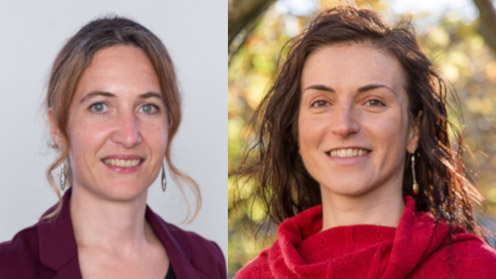Irene Tamborra and Christa Gall Receive Sapere Aude Grants
Two female Associate Professors at DARK, Irene Tamborra and Christa Gall, are the recipients of prestigious 2018 Sapere Aude Starting Grants.

Two female Associate Professors at DARK, Irene Tamborra and Christa Gall, are the recipients of prestigious 2018 Sapere Aude Starting Grants. The Sapere Aude Starting Grants (each 5.9MDKK) are offered by the Independent Research Fund Denmark and are targeted at outstanding, young researchers who intend to carry out competitive research projects at the highest international level.
Irene Tamborra is the Knud Højgaard Associate Professor of Particle Astrophysics and Astrophysics and leader of the AstroNu group at the Niels Bohr Institute; she spends half of her time at DARK and the remaining half at the Niels Bohr International Academy. Christa Gall is an Associate Professor at the Niels Bohr Institute (funded by the Carlsberg Foundation up to now) and is full time at DARK. Irene and Christa are both interested in the astrophysics of transient sources in the Universe, from a theoretical and an observational point of view.
Jan Thomsen, head of the Niels Bohr Institute, is excited: “In addition to allowing these creative young scientists to carry out highly original research projects, the Sapere Aude grants will boost synergies between the different research areas at DARK and at the Niels Bohr Institute and open new collaborations”
At the occasion of accepting the Sapere Aude grant, Irene Tamborra said: "Neutrinos are the most thrilling elementary particles, they never stop surprising us! A new exciting journey bringing us a step closer to understanding the mysteries of the extreme Universe is ahead of us”. Christa Gall added: ”The acronym of my project is SNOTRA — the goddess of wisdom in norse mythology. In the coming years I will discover fascinating astrophysical objects and illuminate their roles in the Universe — in the end I hope we will all get wiser!”
Jens Hjorth, head of DARK (a research unit of the Niels Bohr Institute), concludes: "Besides being leaders in their respective research fields, Irene and Christa enthusiastically work to support women and under-represented minorities in Science. They are great role models in their daily research life."
Background: Irene Tamborra’s research project
Irene's research project, "Compact Astrophysical Objects and Neutrinos," will unveil the secrets behind extreme cosmic fireworks in our Universe by means of an elementary and feebly interacting particle, the neutrino.
Among the most extreme events in our Universe, are the deaths of massive stars in violent supernova explosions. Others arise when two relatively close stars die and leave two neutron stars or a neutron star and a black hole. The two compact objects can start to orbit each other, giving rise to a binary merger. The mechanism behind those cosmic fireworks is full of mysteries, but compact sources are considered to be the main factories of the elements heavier than helium and very likely heavier than iron. Neutrinos have a fundamental but yet to be unraveled role in compact sources.
Irene's project will shed light on the role of neutrinos in the mechanism of compact sources through the development of novel and sophisticated techniques. This is an uncharted territory entailing interdisciplinary work at the interface of astrophysics, particle physics, and nuclear physics. The ultimate goal will be to address some of the most fundamental questions on the mechanism behind compact objects, the impact of neutrinos, and their flavor conversions in the dynamics of compact sources and in the synthesis of new elements.
Irene Tamborra has also recently received a Carlsberg Distinguished Associate Professor Fellowship on the topic of Neutrino Astrophysics (read more here).
Background: Christa Gall’s research project
Christa’s research project, “Supernovae and notable transients”, will use astrophysical transients, such as massive starts exploding as supernovae, to address fundamental questions about the Universe we live in.
The project is a comprehensive study of astrophysical transients which will transform current views in several aspects of astronomy, i.e., what is the origin of cosmic dust and what is the type of dark energy responsible for the accelerated expansion of the universe? This will include to find out if supernovae are the long sought production factories of large cosmic dust grains, and whether the accuracy of measuring cosmological parameters can be improved if we can understand and use the intrinsic physical properties of particular types of transients. Finally, the project will exploit the discovery space opened up by new transient surveys to find and elucidate the nature of rare and yet unknown transients. An example of the discoveries that may result from this project includes measuring the scale of the Universe with gravitationally lensed supernovae.
Contacts:
Irene Tamborra
Phone: +45 35 33 32 27
E-mail: tamborra@nbi.ku.dk
Christa Gall
Phone: +45 53 66 20 18
E-mail: christa@dark-cosmology.dk
